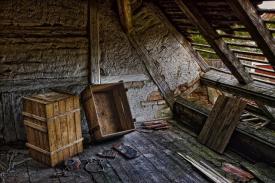
In the early 1980s then high school student Ed Terebus and his older brother, unemployed auto worker Jim, decided to try their hands at the scare-trade by opening their first haunted house attraction.
The haunted house was set up in a trailer filled with hired actors in disguises made of egg yolks and oatmeal. A ticket cost $1.50 per person.
The undertaking proved to be quite profitable, and over the years the business became the four-story haunted house known as Erebus in Pontiac, Michigan. During the years 2005 until 2009 the Guinness Book of World Records said this site was the world’s largest haunted house attraction. By 2010 a larger enterprise surpassed Erebus.
Scaring visitors in this particular manner is a growing business, according to the industry’s trade association, America’s Haunts. They say there are about 1200 large-scale, for-profit haunted attractions in the US, and an additional 3000 haunted houses run by charities and open for business only 1-2 days each year. The commercial endeavors raise between $300 million and $500 million in revenue each year.
Much of the interest and draw of these attractions can be attributed to the advent of technology to make the effects scarier and more realistic.
“Haunted houses are trying to create these immersive environments, and technology often does that,” said Brett Bertolino. Bertolino is the director of operations at Eastern State Penitentiary, a former Philadelphia prison which is transformed once a year into a giant haunted house.
Erebus in Michigan creates its horror with tools like animatronic mutant gorillas and a moving wall that forces guests into what looks like a hole with no bottom. But what is scary to the Terebus brothers is not just the props, but the kind of staff they need to keep the place going.
“I have an IT guy here full time now,” Ed Terebus said. “That’s the scary part.”
To keep things real designers try to make the monsters they use less mechanically predictable by using air-powered devices in tangent with computerized sensors.
“They aren’t on timers where something is going ka-junk, then 30 seconds later, ka-junk,” says Billy Messina, a co-owner of Netherworld, an Atlanta haunted house known for its innovative use of silicone masks on actors to create extremely realistic monsters.
“With the sensors, you can time it so it’s not always the person at the front of a group that’s getting scared,” he said.
As production costs rise and competition between these attractions intensifies, it is no surprise that ticket prices are heading north. Today the average entrance fee is $15, but tickets can cost a cool $65 at some attractions, says America’s Haunts.